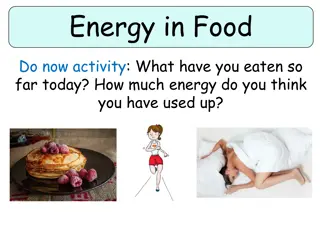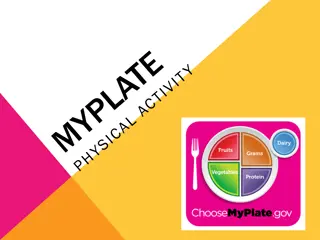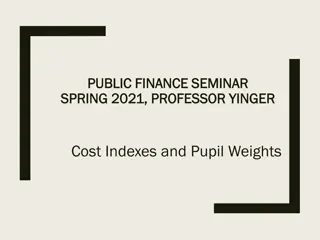Understanding Your Body's Caloric Needs and Energy Expenditure
Uncover the basics of maintaining a healthy lifestyle by learning about your Basal Metabolic Rate, Total Daily Energy Expenditure, and essential habits like proper hydration, nutrition, and exercise. Discover how factors like age, weight, height, and activity level influence your caloric requirements and weight management goals.
Download Presentation

Please find below an Image/Link to download the presentation.
The content on the website is provided AS IS for your information and personal use only. It may not be sold, licensed, or shared on other websites without obtaining consent from the author. Download presentation by click this link. If you encounter any issues during the download, it is possible that the publisher has removed the file from their server.
E N D
Presentation Transcript
Tell Us About You What do you hope to get out of tonight?
1 2 3 4 Identify your SMART Goal and your WHY Physically write both down Identify somebody you can share these with for accountability Choose an action item to adhere to for the next 2 weeks. Circling back to 2/28
Drink your body weight in oz of water each day Modify if necessary Drink Eat Eat 3 servings of fruit/vegetables per day Circling back to 2/28: Healthy Habit Options Eat Eat breakfast every day Eat Eat Protein at every meal Perform Perform at least 5 minutes of deliberate exercise per day Cook or prepare Personally cook or prepare at least 3 of your meals this week Cut out Cut out all naturally and/or artificially sweetened beverages Allow Allow yourself 8 hours of sleep time each night Don t add Don t add salt to any of your food
How many calories does YOUR body need per day to Maintain Maintain your current weight Lose Lose weight Gain Gain Weights
Now Entering The What gets measured gets managed - Peter Drucker
Basal Metabolic Rate Defined As: the number of calories the human body burns per day simply to sustain vital functions such as breathing and keeping warm. (what you would burn if on bed rest)
Age BMR Current Weight Factors that are taken into consideration: Height Gender
Total Daily Energy Expenditure (Break Even) Defined As: the total number of calories you burn each day. (BMR + Activity = TDEE)
Low Activity You get little to no exercise You exercise lightly 1-3 days per week Light Activity Defining Your Activity Level Moderate Activity You exercise moderately 3-5 days per week You exercise heavily 6-7 days per week High Activity Very High Activity You exercise very heavily (i.e. 2x per day, extra heavy workouts)
Lets calculate your TDEE Here s what we need to know: AGE Weight Height (Feet & Inches) Gender Activity Level (Reference previous slide)
Once we have this number, what do we do with it? Put the Equations to the Test: To ensure you have accurately determined your TDEE, it s always a good practice to start eating to this target calorie number while monitoring your weight. In theory, your weight should not change. If your weight goes up, your TDEE is less than calculated and should be adjusted accordingly. May need metabolic rehabilitation If your weight goes down, your TDEE is higher than calculated and should be adjusted accordingly.
Once we have this number, what do we do with it? - Continued To Maintain Your Weight: Your average daily calorie intake should mirror your TDEE
Once we have this number, what do we do with it? - Continued To Gain Weight : In simple terms you should eat MORE than your TDEE Range (100-500 excess calories daily beyond TDEE) In the absence of a strength training program you can expect the majority of your weight gain to consist of adipose tissue or bodyfat. In conjunction with a strength training program a natural man can expect to gain .25 - .5 pounds of muscle per week or 1-2 pounds per month. In conjunction with a strength training program a natural woman can expect to gain .12 - .25 pounds of muscle per week or .5 1 pond per month.
Once we have this number, what do we do with it? - Continued To Lose Weight : In simple terms you should eat LESS than your TDEE By eating 500 fewer calories per day than your TDEE you can expect to lose 1lb per week. By eating 1000 fewer calories per day than your TDEE you can expect to lose 2 lbs per week. By eating 1,250 fewer calories per day than your TDEE you can expect to lose 2.5 lbs per week. It is not recommended that one should lose more than 2.5 lbs per week. To minimize the loss of lean tissue, do this in conjunction with strength training and sufficient protein present in the diet.
Coming up next time Thursday 3/29 @ 6PM Topic: How to leverage technology to effectively and conveniently hit these new found goals.























